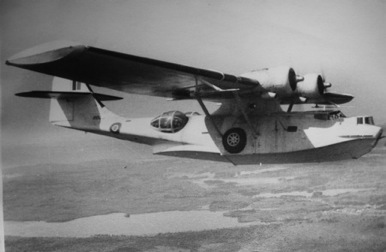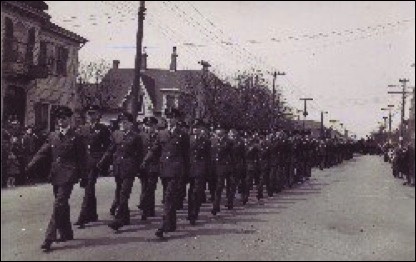
Air Force Adventures

Ice rescue:
Spring was break-up time on the St. Lawrence, and the river was cluttered with a massive ice flow. On this fateful day, a small single engine mail plane from Halifax left for Montreal with its three-man crew. Unfortunately, due to mechanical problems, the small plane was forced down in the entrance of the river on an ice flow no larger than a schoolyard. Not only was this a cold time of the year to be forced down, but the aircraft slid right off the ice into the frigid northern water. The men were alone, stranded and drifting out to sea. To make matters even worse, these ice flows were frequented by bears feeding on the fish attracted by the spring outflow. Thankfully, an American service aircraft enroute to Gander, Newfoundland noticed the three men and radioed for help. Before leaving, the pilot dropped some blankets and a pup tent on to the ice to protect them until help arrived.
Father was on duty that day as they prepared for an offshore patrol from their base at Torbay, Newfoundland. 161 Squadron had been flying long-range patrols along the coast and up the river watching for German submarines lurking in the waters. Submarines had been known to come up river as far as Montreal! One crew of an enemy submarine that surrendered was found with “theatre ticket stubs in their pockets.” They had been ashore in Montreal for a night out on the town. (What a way to fight a war!)
As the amphibious Canso warmed up on the runway, they received information regarding the stranded men on the ice in the Gulf of St. Lawrence. It was Father’s aircraft that was deployed on the rescue mission to save that downed crew. Dad was the aero engineer aboard and was stationed in the “tower” between two screaming Pratt & Whitney Wasp engines. Once airborne, it took some searching on that vast span of ice-ridden water to find the men. It would be like you and me trying to spot flies on the sunny side of the house across the street! The search took several hours. Finally, the men were spotted and Jim Harrison, the pilot, attempted to drop a sleeping bag with a two-way radio inside. Sadly, the package slid across the ice into the river, lost forever.
Not able to risk a landing in such treacherous water, they were instructed to keep the men company so as not to lose them amongst the massive ice flow. Harrison was finally successful in contacting a distant icebreaker heading north out of Halifax. The ship was heading toward Anticosti Island when Harrison gave them the coordinates of the lost men.
The crew of the Canso, from their lofty view, could see the icebreaker turn in the distance and vector a course straight toward the stranded three. They waited several more hours circling the survivors until all at once the Canso’s engines sputtered and quit! Harrison grabbed the mike and hollered, “Frankie, what the hell happened!” “Frankie” frantically searched the instrumentation for a clue. By the time Harrison had yelled a second time, Father had found the problem. The fuel tanks were fitted with a selector switch that restricted fuel flow from one tank or the other. As per normal flying conditions, the switch was set in the middle to ensure an equal flow from both tanks. Orbiting the ice flow, however, Harrison had kept one wing down for several hours effectively draining the fuel from the high tank first until that tank was dry and the engines went silent.
Silence of that nature is a frightening experience when one is hundreds of miles from home with no hope of a safe landing in sight! With the problem rectified, the men now continued to circle the survivors until the icebreaker was able to pick them up. A call from Eastern Air Command warned the Canso not to attempt a flight back to the base at Torbay but redirected them to Halifax to refuel.
By the time Captain Harrison slipped on to the runway at Dartmouth, they had spent 20 hours in that throbbing aluminum bucket. Father and the crew were half deaf, hungry, and their eyes were bloodshot from the glare off of hundreds of miles of ice and water. The Canadian support staff was ready for the rescuers and had a delectable t-bone steak supper waiting in the officer’s mess for the hungry crew.
These were days of daring and danger for our servicemen at home and across the sea. On lonely night patrols, the Cansos, or flying boats as they were called, often quietly swooped in on a radar contact hoping to surprise a submarine on the surface. More than once, the pilot was astonished to find that his radar contact turned out to be a large iceberg.
This was extremely disconcerting and required nerves of steel and quick reflexes to avoid crashing into a wall of ice. One year, a huge iceberg floated by on its journey south, that had a large hole in its vertical flat face. The hole was large enough for powerboats to get through and was even tried by more than one aircraft. Apparently the pilots were actually as good as they thought they were, because no reports of loss were ever filed.
Father, who was a prairie boy, mused over the very different life style and antics of the resident Newfoundlanders around the airbase. He recalls watching the “Newfies” push a large iceberg into the bay with their old sea boats. This was a clever work-saving initiative that allowed them to fish right at home as the fish were attracted by cool water surrounding the ice.
Those Brits!
Near the end of the war, Mother & Dad moved to Hebron near Yarmouth Nova Scotia. Dad’s job was assimilating British Officers into the R.C.A.F. for the purposes of fighting in the Korean War. It was at that time that the unruly Brits would fly in with their Lancaster Bombers and land just about anywhere, fields or highways, only to be found later in a town pub, having a good time.
Two-wheel disaster:
During this posting to Yarmouth, Father rode to work on a bicycle. To speed up the trip, he would often try to hitch a ride by grabbing onto the rear handrail of a passenger bus. The bus drivers, of course, were less than happy with this arrangement and would often drive over next to the parked cars along the side of the streets, which of course made bicycling considerably less safe. Once, while cruising down hill at top speed on his bike, Father was riding next to the row of parked cars on the street. Suddenly, someone opened the large door of a ‘35 Chevy, too close for him to get stopped. His momentum nearly took the door off, crashing through the window and back onto the street! All skinned up and bleeding on the roadway, he was helped into a nearby restaurant and someone called the Airforce base to come and get him.
Even in his 89th year, father still remembered the grand days of growing up on the prairies and the adventures of war time. We are so thankful for those hundreds of prairie boys and other brave Canadian men and women that fought for the freedom we enjoy today. Sadly, many like my uncle Bill Hampton, never returned from the war but their sacrifice is ever appreciated. 60,000 Canadian soldiers sacrificed their lives in World War Two so that the murderous Nazis could be prevented from ruling the world.
To our brave Canadian soldiers We will always remember you!
(Pilot Officer Bill Hampton, a paratrooper, was shot and killed in the air while making a jump behind enemy lines on D-day.)
I've written an historical novel based upon Fathers memories of the war and his love for our country and freedom. This book also depicts many of the difficulties that our Senior's face later in life as they watch today's disturbing global news and remember the past.
The book is entitled "A Time to Run" by Douglas Warren Greenfield.
~ “Those who do not remember the past will be condemned to relive it!” ~
Read this book

Left marker, F.W. Greenfield on parade in Yarmouth, N.S.